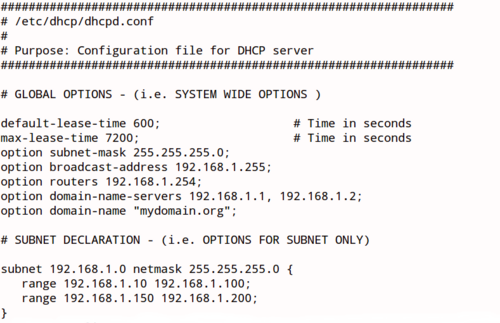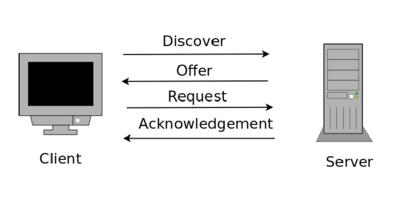Difference between revisions of "OPS235 Lab 8 - CentOS7"
| Line 191: | Line 191: | ||
# Remain in your '''centos2''' and '''centos3''' VMs for this section. | # Remain in your '''centos2''' and '''centos3''' VMs for this section. | ||
# If your '''centos3''' DHCP server successfully issued the proper IP address configuration values to '''centos2''', check the file called:<br>'''/var/lib/dhcpd/dhcpd.leases''' in your <u>'''centos3''' VM</u>. You should the similar contents:<br><br> | # If your '''centos3''' DHCP server successfully issued the proper IP address configuration values to '''centos2''', check the file called:<br>'''/var/lib/dhcpd/dhcpd.leases''' in your <u>'''centos3''' VM</u>. You should the similar contents:<br><br> | ||
| − | |||
| − | |||
::<span style="font-family:courier;"> lease 192.168.235.51 {</span> | ::<span style="font-family:courier;"> lease 192.168.235.51 {</span> | ||
::<span style="font-family:courier;"> starts 5 2015/07/10 17:57:34;</span> | ::<span style="font-family:courier;"> starts 5 2015/07/10 17:57:34;</span> | ||
| Line 204: | Line 202: | ||
::<span style="font-family:courier;"> }</span> | ::<span style="font-family:courier;"> }</span> | ||
<br><br> | <br><br> | ||
| − | <ol><li value="3">On the client '''centos2''' check the contents of the <code>/var/lib/dhclient</code> directory. The files in this directory is where the dhclient stores its record of leases.</li> | + | <ol><li value="3">On the client '''centos2''' check the contents of the <code>/var/lib/dhclient</code> directory. The files in this directory is where the dhclient stores its record of leases.<br><br></li> |
</ol> | </ol> | ||
Revision as of 13:16, 10 July 2015
Contents
LAB PREPARATION
Overview
There are various ways in which computers can be networked together. Some computer networks (such as computer labs) configure their workstations for static IP addresses for security and to provide other interesting features such as WOL (Wake Up on Lan) which allows a signal from a computer system to remotely start all or specified workstations within the lab. Hot-spots (such as cafes or airport lounges) offer the ability for users to connect to the Internet (via DHCP) from their mobile devices (notebooks, netbooks, tablets, or smart phones). Finally, there are hybrid solutions that may offer both fixed IP address (computer workstations) and allow for wireless connections (via DHCP) to a mobile devices (like at your Seneca computer labs).
In lab6, you learned to connect your VMs to a VPN using a fixed IP Address. In this final lab, you will learn to set-up a DHCP server to automatically assign IP Addresses upon connection requests.
Main Objectives
- To install, configure, and test ISC's DHCP Server.
- To obtain log information from DHCP server including lease address information.
- To lease the same IP address every-time from VM boot-up (instead of having DHCP server randomly assign IP address).
Minimum Required Materials
My Toolkit (CLI Reference)
Each Link below displays online manpages for each command (via http://linuxmanpages.com):
| Networking Utilities: | Additional Utilities: | Configuration Files: |
INVESTIGATION 1: INSTALL AND CONFIGURE A DHCP SERVER
This lab will demonstrate setting up a DHCP server. The term DHCP stands for Dynamic Host Configuration Protocol. DHCP allows computers (eg. workstations, notebooks, smart-phones) to be automatically configured so that they can communicate over a network. This automatic configuration has gained popularity over the years, especially as the need for detecting and configuring portable computer devices increases. DHCP configuration allows for various setups including: Dynamic, Automatic, and Static allocation.
The term DORA best describes how DHCP Works:
| Discovery: | The client broadcasts a message (IP lease request) on a sub-network to discover available DHCP servers |
| Offer: | The DHCP server receives the request from the client, reserves an IP ADDRESS for the client and sends a DHCPOFFER |
| Request: | The DHCP server broadcasts a message request for acceptance, but also notifies other DHCP server |
| Acknowledgement: | The client sends a message of acceptance to the server. In turn, the client receives from the server a packet of information containing the lease duration and other configuration information |
Part 1: Installation of a DHCP
- Perform this section in your centos3 VM.
The version of DHCP server that comes with CentOS is maintained and distributed by the Internet Software Consortium (http://www.isc.org). The source package that you can download from ISC includes not only the DHCP server, but also a DHCP client and a DHCP relay agent. CentOS separates it into two RPM packages: the DHCP client package and the DHCP server package. The DHCP client package is installed by default by the workstation installation. - To check that you have dhclient installed, enter the command:
-
rpm -q dhclient
-
- If the package is not installed, you will get the message "package dhclient is not installed", otherwise, you will get the version information of the rpm package. Install the dhclient package if it was not installed.
- Issue the following command to install the dhcp server package:
yum install dhcp - Enter the command to list all the files installed from the DHCP server package by issuing the command:
rpm -qla dhcp - What file appears to be a sample (example) configuration file for dhcpd.conf?
- Copy the dhcpd.conf.example file to the /etc/dhcp directory making sure it is named: /etc/dhcp/dhcpd.conf
Answer Part 1 observations / questions in your lab log book.
Part 2: Configuring the DHCP Server

NOTE: Any errors in this file (such as typos or missing semi-colons) can cause the DHCP server not to restart!
- Remain in your centos3 VM for this section.
- Click on the following link to access the online manual page for the following DHCP items to gain an understanding:
- Study the sample dhcpd.conf file to see examples of how these options are used.
- Edit /etc/dhcp/dhcpd.conf and examine the top section of the file.
- Look for the comment: "option definitions common to all supported networks"
- Below that comment change the existing global options to reflect the newer values shown below:
domain-name "ops235.org";
domain-name-servers 192.168.235.1;
default-lease-time 1200;
max-lease-time 3600;
Note: Any values for time are stated in seconds. - View your editing sessions for typos (check for missing semicolons), then save and exit your editing session.
Answer Part 2 observations / questions in your lab log book.
Part 3: Configuring DHCP Server for Static IP Addresses
- Remain in your centos3 VM for this section.
- Edit /etc/dhcp/dhcpd.conf for a second time.
- View this file for existing subnet declarations. Note the syntax and the directive for range and the option for routers (gateway).
- Now, add a new subnet delcaration for your virtual network:
The network address is: 192.168.235.0/255.255.255.0
range of host addresses should be from: 51 to 60
default gateway (routers) for the virtual network is: 192.168.235.1 - Save your editing session, and exit the text editor.
- Open another terminal window (ssh into centos3 from the centos host as user root) and issue the following command:
tail -f /var/log/messages
(This will show you the last lines of /var/log/messages continue to display new lines as they are added to the log.) - In your original terminal prompt attempt to start the dhcpd service.
- You should see new lines being added to the messages file.
- If the dhcpd service fails to start any error messages will be logged in the messages file. Read the errors and attempt to fix your configuration file.
- If the dhcpd service starts successfully you should see success messages in the log.
- If your dhcpd service starts successfully, try to generate errors by editing the configuration file and introduce an error by removing a semicolon or closing curly bracket.
- Restart your dhcpd service and observe the error messages generated. This is good practice to learn how to trouble-shoot and solve dhcpd errors.
- Make certain that you have corrected those errors, and that your dhcpd service works properly.
- Once the dhcpd service has is running, use the systemctl command to see if the dhcpd service is enabled. If it is not enabled, use the chkconfig command to enable the dhcpd service so it started automatically upon boot-up.
Answer Part 3 observations / questions in your lab log book.
Part 4: How do I test my dhcpd service on my virtual network?
- Use your centos2 and centos3 VMs for this section.
- On your centos3 terminal window (via ssh from your c7host machine) make sure that the command
tail -f /var/log/messages is running. - On your centos2 VM, change the configuration of eth0 (or your interface name) to receive dynamic address configuration (i.e. via graphical application, for IVP4 tab, change Address from Manual to DHCP, and Apply settings)
(Refer to Lab6, Investigation1, Part2).
Note: if you are configuring via command line, make certain to restart the network for centos2. - Logout and restart your centos2 VM.
- Observe the messages that get logged from the tail -f command as your centos2 VM starts. You should see output similar to the following:
- Mar 24 13:28:24 centos3 dhcpd: DHCPDISCOVER from 52:54:00:61:00:e7 via eth2
- Mar 24 13:28:25 centos3 dhcpd: DHCPOFFER on 192.168.235.51 to 52:54:00:61:00:e7 via eth2
- Mar 24 13:28:25 centos3 dhcpd: DHCPREQUEST for 192.168.235.51 (192.168.235.13) from 52:54:00:61:00:e7 via eth2
- Mar 24 13:28:25 centos3 dhcpd: DHCPACK on 192.168.235.51 to 52:54:00:61:00:e7 via eth2
- On centos2, confirm the IP address assignment using
ifconfig - Has the IP Address changed? If so, how has the IP Address been assigned according to the dhcpd.conf file settings?
Answer Part 4 observations / questions in your lab log book.
INVESTIGATION 2: OBTAINING LEASE & LEASE PERMANENT IP ADDRESS INFORMATION
Part 1: Obtaining Leased Address Infomation
- Remain in your centos2 and centos3 VMs for this section.
- If your centos3 DHCP server successfully issued the proper IP address configuration values to centos2, check the file called:
/var/lib/dhcpd/dhcpd.leases in your centos3 VM. You should the similar contents:
- lease 192.168.235.51 {
- starts 5 2015/07/10 17:57:34;
- ends 5 2015/07/10 18:17:34;
- cltt 5 2015/07/10 17:57:34;
- binding state active;
- next binding state free;
- rewind binding state free;
- hardware ethernet 52:54:00:0e:7d:a4;
- client-hostname "centos2";
- }
- On the client centos2 check the contents of the
/var/lib/dhclientdirectory. The files in this directory is where the dhclient stores its record of leases.
Answer Part 1 observations / questions in your lab log book.
Part 2: Configuring DHCP server to Continually Lease Same IP Address
- Remain in your centos2 and cento3 VMs for this section.
- Make certain that you are located in your centos3 virtual machine.
- Create a host declaration for centos2. Make sure you record the correct
hardware ethernetsetting that corresponds to the MAC address of the interface in centos2. - Give it the fixed-address 192.168.235.12
Note: When supplying fixed-address it is important that the address assigned is exclusive of any ranges that have been declared. Otherwise it may be possible for 2 different hosts to receive the same address.
- Start your service and test the address assignment by releasing your current address on centos2 and then requesting a new address. Use the following commands on centos2:
-
ifdown eth1 -
ifup eth1
-
- Confirm that you received the fixed address you were supposed to.
Answer Part 2 observations / questions in your lab log book.
LAB 8 SIGN-OFF (SHOW INSTRUCTOR)
Arrange proof of the following on the screen:
- ✓ centos2 VM:
- DHCP client lease file
- ✓ centos3 VM:
- DHCP server log file showing a lease occuring
- DHCP server configuration file showing subnet and host declaration
- DHCP server lease file
- ✓ Lab8 log-book filled out.
Preparing for Quizzes
- What protocol and port does dhcp use?
- What file is used to configure dhcpd?
- Can a dhcp server also be a dhcp client?
- What is the difference between max-lease-time and default-lease-time?
- What unit of measurement does default-lease-time require?
- What dhcp option is used for configuring a default gateway?
- What is the parameter range in the DHCP server configuration file used for?
- What is the purpose of a dhcp relay agent?
- Why might a dhcp relay agent be required?





